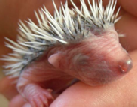

Injured Hedgehog
And ‘Your Shout’
Patients Gallery

|
21 grams 2- |
24 grams 5- |
24 grams 5- |
6- |
7- |
WHEN THEY MAY BE FOUND
Hoglets may be found abandoned in May, June or July, when the
first litters are generally born, and in August/September, when the second litters
appear. The average size of a litter is four to five, and they appear after a five
week pregnancy. If you find one or two, the area should be searched as there may
be others, either still in the nest or nearby.
WHY THEY MAY BE FOUND
If the mother is disturbed after the birth, she may desert her
litter. Many more hoglets are made orphans because their mother is killed or injured
on the roads, dies because of garden or farmland hazards, falls into a cattle grid
without an escape ramp or is poisoned by pesticides.
WHERE THEY MAY BE FOUND
Favourite nesting sites of hedgehogs are: under a garden shed,
in a hedgerow, pile of garden debris or a compost heap. You may hear their distressed,
shrill, bird-
WHAT TO DO WHEN YOU FIND THEM
Abandoned hoglets are vulnerable creatures and are often
found in a poor state. For survival, human help is needed quickly, and generally,
two things are needed urgently -
HOW TO PROVIDE WARMTH FOR THEM
Warmth is absolutely vital. The hoglets should be kept
in a temperature of no less than 24°C (75°F) by using: a well-
Once you have wrapped up the hoglets to keep them warm, please call your local hedgehog rescue centre where they will have the facilities and knowledge to care for them.
STRESS REDUCTION -
ONE WEEK OLD weighs about 28-
TWO WEEKS OLD (weighs about 56-
THREE WEEKS OLD (Weighs about 85-
FOUR WEEKS OLD (Weighs about 113-
FIVE WEEKS OLD (weighs about 190-
SIX TO SEVEN WEEKS OLD (weighs about 225-
EIGHT WEEKS OLD (weighs about 350gms [12oz])
FACTS YOU MIGHT LIKE TO KNOW ABOUT HEDGEHOGS & HOGLETS:
· The length of a hedgehog pregnancy is somewhat variable. It is believed that if
for instance, a cold spell of weather in spring brings about a shortage of natural
food, a pregnant hedgehog will resume hibernation and the development of her embryos
will slow down. When she is active again the embryos continue to grow and the pregnancy
is lengthened by the same amount of time as the hibernation period.
· When hoglets are born they are bright pink and do not have visible spines. These
are under the skin covered by a layer of fluid, like a large water blister. Soon
after birth the spines erupt through the skin.
· The new spines are white but brown ones appear amongst them and by the time the
hoglet is fifteen days old the white ones are hardly visible.
· Hedgehogs shed their spines just as humans shed their hair.
· It is thought that 1 in 5 of all hoglets die before they leave the nest.
· When hedgehog litters leave the nest and disperse they are unlikely to meet again
as they live solitary lives.
· Hedgehogs are not usually sexually mature in the year of their birth but commence breeding in their second year.





